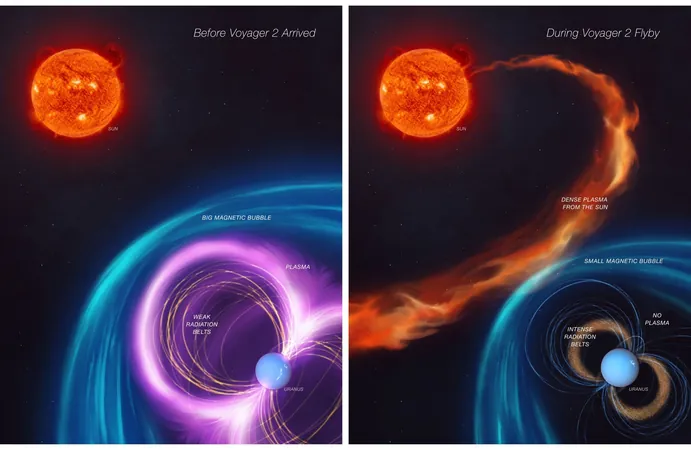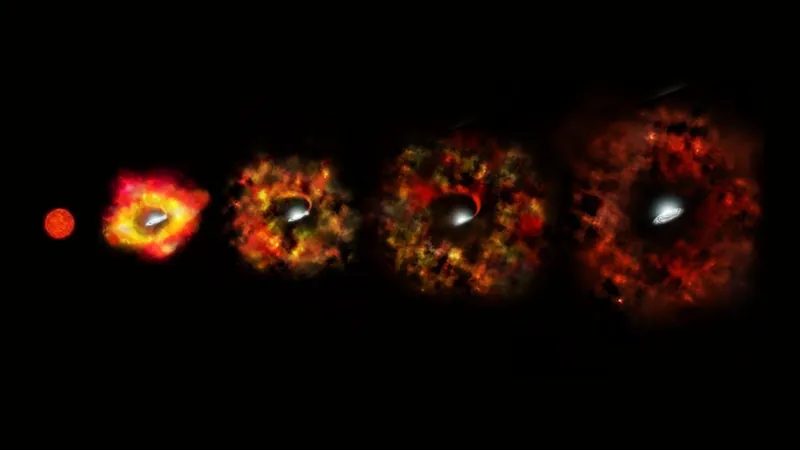
Unlocking Uranus: How Voyager 2 Data Reveals Secrets of Our Solar System's Most Enigmatic Planet
2024-11-11
Author: Emma
Groundbreaking Revelations from Voyager 2
In a groundbreaking revelation, new research analyzing data from NASA's Voyager 2 spacecraft, which flew by Uranus in 1986, has solved long-standing mysteries about the seventh planet in our solar system. This flyby was not just the first but as of now, the only close-up examination of Uranus, bringing with it exciting discoveries and pressing questions.
Surprising Features and Perplexities
During the Voyager 2 encounter, scientists noted surprising features, including new moons and an extraordinary magnetic field. However, perplexities arose when the magnetosphere surrounding Uranus appeared to behave oddly, challenging existing theories of planetary magnetism. The energetic particles around the planet seemed to defy conventional understanding, leading researchers to label Uranus as a peculiar outlier among its planetary peers.
Unraveling the Mysteries
Recent analyses of Voyager 2's data have uncovered the root of these mysteries. It turns out that a unique space weather event occurred just days before the spacecraft's flyby, seriously compressing Uranus's magnetosphere and altering its magnetic field. As Jamie Jasinski from NASA's Jet Propulsion Laboratory explains, “If Voyager 2 had arrived just a few days earlier, it would have observed a completely different magnetosphere at Uranus.” In fact, the conditions recorded by Voyager 2 represented a rare situation that occurs merely 4% of the time.
Importance of Magnetospheres
Magnetospheres act as protective shields for planets with magnetic cores, like Earth, guarding them against energetic plasma ejected by the sun. Understanding how these systems function is crucial not just for Earth’s current state but also for exploring other less-studied regions of our solar system.
Radiation Activity Near Uranus
What astonished researchers back in 1986 was the radiation activity near Uranus, which boasted electron radiation belts rivaling those of Jupiter. Yet, there seemed to be a notable absence of the plasma that is typically generated by the icy moons surrounding Uranus. This absence led scientists to conclude that these moons might be inactive or dormant.
New Findings on Moon Activity
However, the findings of the new study suggest otherwise. The analysis confirms that the solar wind had a significant impact, compressing the magnetosphere and potentially pushing plasma out of the system while simultaneously fueling the radiation belts with energized electrons. This exciting conclusion opens the possibility that Uranus’s major moons might be geologically active after all, challenging previous assumptions about their inert states.
Future Exploration of the Uranus System
The implications of this research reverberate through the planetary science community. The Uranus system has now emerged as a high-priority target for future exploration, as highlighted by the National Academies' 2023 Planetary Science and Astrobiology Decadal Survey.
Reflections from Voyager's Team
Linda Spilker, a veteran of the Voyager 2 mission, reflected on the excitement of the original flyby and the immediate aftermath. "The flyby was packed with surprises, and we were searching for an explanation of its unusual behavior," she recalled. "This new work explains some of the apparent contradictions and will change our view of Uranus once again."
Voyager 2's Ongoing Journey
Voyager 2 continues its journey into interstellar space, currently approximately 13 billion miles (21 billion kilometers) from Earth, reminding us of our unquenchable thirst for knowledge about the mysteries of the universe. Who knows what other secrets arise as we dive deeper into data from this historic mission? Stay tuned for further revelations as planetary scientists piece together the puzzle of Uranus and beyond!









 Brasil (PT)
Brasil (PT)
 Canada (EN)
Canada (EN)
 Chile (ES)
Chile (ES)
 España (ES)
España (ES)
 France (FR)
France (FR)
 Hong Kong (EN)
Hong Kong (EN)
 Italia (IT)
Italia (IT)
 日本 (JA)
日本 (JA)
 Magyarország (HU)
Magyarország (HU)
 Norge (NO)
Norge (NO)
 Polska (PL)
Polska (PL)
 Schweiz (DE)
Schweiz (DE)
 Singapore (EN)
Singapore (EN)
 Sverige (SV)
Sverige (SV)
 Suomi (FI)
Suomi (FI)
 Türkiye (TR)
Türkiye (TR)